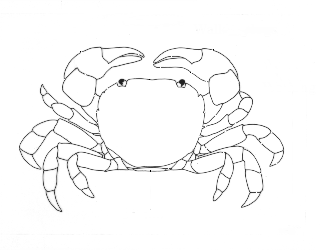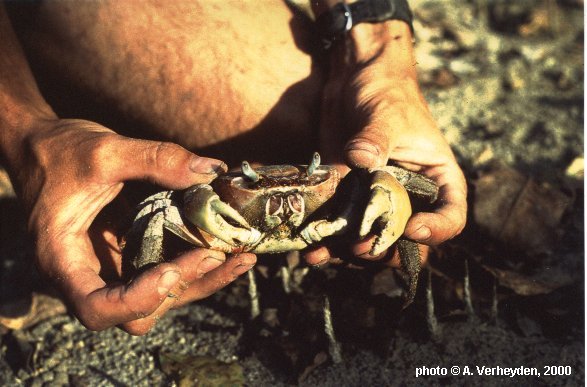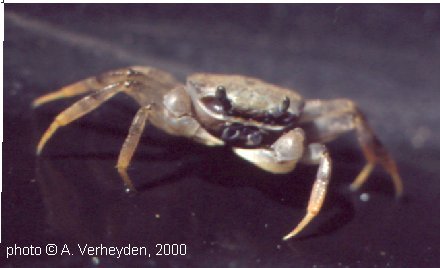
|
A field guide to Kenyan
mangroves
|
|
Cardisoma carnifex (Herbst, 1794)
Family: Geocarcinidae

Cardisoma carnifex is the largest of the semi-terrestrial crabs in Kenyan mangroves, the only larger crab associated with Kenyan mangroves is Scylla serrata. These crabs can be seen running accros roads near the coast and live in coastal gardens as well. The name Cardisoma comes from Cardi = heart and soma = body.
Zone: Landward Avicennia marina - upper shore - Common in this zone - Also present in coconut plantations (Lee, 1988).
|
Habitat: Burrowing up to 2 meters depth (Hogue and Bright, 1971; Gillikin, 2000). Food: Omnivourous, but stomach content analysis shows that they primarily consume A. marina leaves (Dahdouh-Guebas et al., 1999). Ecological notes: Larvae go through five zoeal stages lasting from 22-25 days and one megalopa stage (Kannupandi et al., 1980). Hogue and Bright (1971) excavated six burrows in Kilifi Creek, Kenya and gave general descriptions which are in agreement with Gillikin (2000). Cardisoma carnifex burrows are large (usually 8 to 12 cm diameter), round, have a well-defined entrance and are hooded by a semi-circular mound of dried mud (Micheli et al., 1991; Gillikin, 2000) and their excavation pellets are rod-shaped (Hogue and Bright, 1971) [compare with N. meinerti]. A very approximate volume of sediment extracted per burrow was calculated for the average burrow diameter giving 778 cm3 (Gillikin, 2000). Burrow associates observed include S. ortmanni, mosquitoes and mosquito larvae. Nothing or little is known of the life history of this or any land crab (Hartnoll, 1988), however recent findings are shedding some light on the ecology and growth rate of juvenile C. carnifex (Gillikin, 2000). Distinguishing characteristics: Heart shaped body, large size, maroon coloration, dimorphism in claws. Carapace width about 10 cm. Geographical range: Red Sea to Natal, Aldabra, Anadamans, Japan, Formosa, Celebes and Polynesia and is the only species of Gecarcinidae found in East Africa (Vannini. and Valmori, 1981). |
|

Juvenile C. carnifex (carapace width = 15.0 mm)
References:
Bright, DB & Hogue, CL. 1972. A Synopsis of the burrowing land crabs of the world and list of their symbionts and burrow associates. Los Angles County Natural History Museum, Contributions in Science 220: 1-58.
Cameron, J.N., 1981. "Acid-base responses to changes in CO2 in two Pacific crabs: the coconut crab Birgus latro, and a mangrove crab, Cardisoma carnifex." Journal of experimental Zoology 218:65-73.
Cannicci, S., F. Dahdouh-Guebas and L. Montemagno, 1993. "Field Keys for Kenyan Mangrove Crabs." Museo Zoologico "La Specola", Dipartimento di Biologia Animale e Genetica dell'Universitą Degli Studi di Firenze, Via Romana 17, I-50125 Firenze, Italia.
Dahdouh-Guebas, F., M. Giuggioli, A. Oluoch, M. Vannini & S. Cannicci, 1999. "Feeding habits of non-ocypodid crabs from two mangrove forests in Kenya." Bull. Mar. Sci. 64(2): 291-297.
Gillikin, D.P., 2000. Factors controlling the distribution of Kenyan brachyuran mangrove crabs: Salinity tolerance and ecophysiology of two Kenyan Neosarmatium species. M.Sc. Thesis, Free University of Brussels, Brussels, Belgium.
Gross, W.J., R.C. Lasiewski, M. Dennis and P. Rudy Jr., 1966. "Salt and water balance in selected crabs of Madagascar." Comparative Biochemistry and Physiology 17: 641-660.
Harris, RR and GA Kormanik, 1981. Salt and water balance and antennal gland function in three Pacific species of terrestrial crab (Gecarcinus lateralis, Cardisoma carnifex, Birgus latro). II. The effects of desiccation. Journal of Experimental Zoology 218: 107-116.
Hartnoll, R.G., 1988. Growth and Molting. In: W.W. Burggren and B.R. McMahon (eds.) Biology of the Land Crabs Cambridge University Press. Cambridge, UK. Pp 186-210.
Hogue, CL & Bright, DB. 1971. Observations on the biology of land crabs and their burrow associates on the Kenya coast. Los Angeles County Natural History Museum, Contributions in Science 210: 1-10.
Kannupandi, T, S. Ajmal Khan, Mercy Thomas, S. Sundaramoorthy and R. NAtarajan , 1980. "Larvae of the Land crab Cardisoma carnifex Herbst (Brachyura: Gecarcinidae) Reared in the Laboratory." Indian Journal of Marine Sciences 9: 271-277.
Kormanik, GA and RR Harris, 1981. Salt and water balance and antennal gland function in three Pacific species of terrestrial crab (Gecarcinus lateralis, Cardisoma carnifex, Birgus latro). I. Urine production and salt exchanges in hydrated crabs. Journal of Experimental Zoology 218: 97-105.
Lee, M.A.B., 1988. "Food preferences and feeding behavior of the land crab Cardisoma carnifex." Micronesica 21: 274-279.
Macnae, W., 1968. A General Account of the Fauna and Flora of Mangrove Swamps ad Forests in the Indo-West-Pacific Region. Advanced Marine Biology 6:73-270.
Micheli, F., F. Gherardi, and M. Vannini, 1991. "Feeding and Burrowing Ecology of Two East African Mangrove Crabs." Marine Biology 111:247-254.
Morris, S. and A.M. Adamczewska, 1996. "Respiratory, acid-base and ion status during voluntary immersion of the air-breathing crab Cardisoma carnifex assessed in situ." Journal of Experimental Marine Biology and Ecology 206(1-2): 149-164.
Rivere et al, 1998. "Ecology of Aedes polynesiensis, mosquito vector of Banerofs filariasis II : studies in land crab holes of Cardisoma carnifex." Anneles de la Society entomology de France 34(3): 259.
Silas, EG and Sankarankutty, C. 1960. On the castle building habit of the crab Cardisoma carnifex (Herbst) (family Geocarcinidae) of the Andaman Islands. Journal of the marine biological association of India, 2: 237-240.
Vannini, M. and P. Valmori, 1981. Researchers on the coast of Somalia. The shore and the dune of Sar Uanle. 30. Grapsidae (Decapoda Brachyura). Monitore Zoologico Italiano 6: 57-101.
Wood, C.M. and R.G. Boutilier, 1985. "Osmoregulation, ionic exchange, blood chemistry and nitrogenous waste in the land crab Cardisoma carnifex: a field and laboratory study." Biological Bulletin of the Marine Biology Laboratory, Woods Hole 169: 267-290.